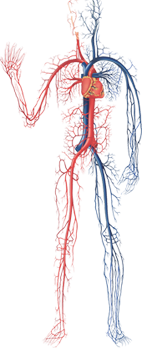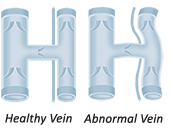
Our veins are an integral part of our circulatory system.
The role of the circulatory system is to transport blood around the body, using a network of arteries, veins and capillaries. Our arteries deliver nutrient-filled, oxygenated blood from the heart to all of the cells in our body. The nutrients are absorbed into the cells and our veins then transport the “used” deoxygenated blood back to the heart.
Our arteries have a somewhat easier job than our veins, in that they have the strength of the heart muscle helping to pump the blood around our body. Gravity is also on the arteries side, as most of blood travels downwards with gravity to the rest of our body.
Our veins, on the other hand, have the tough job of pumping blood upwards to the heart against the force of gravity. Two things aid this process – our leg muscles and the one-way valves inside our veins.
Firstly, the movement of our leg muscles acts as a “second heart” to help pump the blood upward through our veins towards our heart.
Secondly, our veins have inbuilt one-way valves to prevent the backflow of blood and ensure that blood keeps moving forward and never backward. This system allows the blood to flow back to the heart.
The role of the circulatory system is to transport blood around the body, using a network of arteries, veins and capillaries. Our arteries deliver nutrient-filled, oxygenated blood from the heart to all of the cells in our body. The nutrients are absorbed into the cells and our veins then transport the “used” deoxygenated blood back to the heart.
Our arteries have a somewhat easier job than our veins, in that they have the strength of the heart muscle helping to pump the blood around our body. Gravity is also on the arteries side, as most of blood travels downwards with gravity to the rest of our body.
Our veins, on the other hand, have the tough job of pumping blood upwards to the heart against the force of gravity. Two things aid this process – our leg muscles and the one-way valves inside our veins.
Firstly, the movement of our leg muscles acts as a “second heart” to help pump the blood upward through our veins towards our heart.
Secondly, our veins have inbuilt one-way valves to prevent the backflow of blood and ensure that blood keeps moving forward and never backward. This system allows the blood to flow back to the heart.
What Can Go Wrong?

The effectiveness of the one-way valves and the elasticity of the vein walls can be damaged or reduced, which results in a backflow of blood and pooling in the veins. These veins then engorge and dilate. This is called venous insufficiency and affects approximately 10-25% of the population.
Venous insufficiency commonly appears as spider veins, reticular veins or varicose veins.
Venous insufficiency commonly appears as spider veins, reticular veins or varicose veins.
What Does This Mean?
In cases of Venous Insufficiency, abnormal veins place an extra burden on deeper veins to deliver blood to the heart and inhibit circulation in the legs.
Symptoms associated with this include pain, fatigue, aching, swelling, cramping and restless legs. If left untreated, abnormal veins can lead to a range of conditions including spider veins, varicose veins, leg ulcers, infection, and even blood clots such as Deep Vein Thrombosis.
Symptoms associated with this include pain, fatigue, aching, swelling, cramping and restless legs. If left untreated, abnormal veins can lead to a range of conditions including spider veins, varicose veins, leg ulcers, infection, and even blood clots such as Deep Vein Thrombosis.
Do I Need These Veins?
No. Spider veins, reticular veins and varicose veins are dysfunctional superficial veins that fail to return blood to the heart, therefore imposing an extra burden on the deeper veins. Once these damaged veins are removed, our circulation can improve and our blood can return to the heart.









